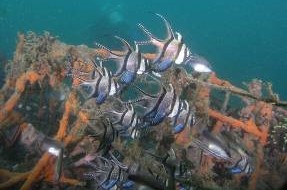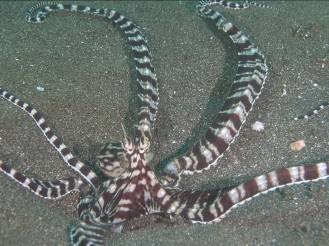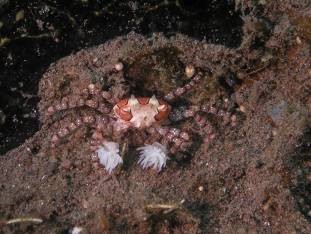News
Jewels in the Muck

Muck diving in Bali
There is nothing as satisfying as a cup of hot strong sweet black Balinese coffee, served in a glass on the beach after your first muck dive. And there is nothing as astonishing as the critters you find in the old car tyres, empty beer bottles, lost bikini tops and empty foil packets covered in ancient volcanic ash silt.

Adi Assri Resort
This is Muck Diving in Bali. As a spoiled South African Sodwana Bay diver and a confirmed addict of well-balanced reefs, pristine corals and beautiful shoals, I had never realised that there could be a secret thriving world of resourceful marine life in the desert wastes of the undersea world, where tides regularly sweep away their habitat and man provides most of their hiding places.
It was a 10 hour flight on Air Malaysia to Kuala Lumpur, then a short 2.5 hour transfer to Bali, which is 6 hours ahead of South Africa. We paid extra for the VIP Meet and Greet and Border Visa service offered by our Dive Operator and we were whisked through the airport immigration as “crew” and through customs in 5 minutes. The Dive Operator’s air-conditioned mini bus carried us through the ancient Spice Island plantations of cinnamon, nutmeg and cloves, and we arrived at the Adi Assri resort in Gilimanauk, home for our first week. We spent the next day getting used to the new time zone and discovering that fruit and fresh vegetables are very big in Bali, Bintang Beer excellent, and Balinese food is best – Hindu’s are not big on beef, so avoid steaks at all costs. Magnum ice-cream is everywhere. Cash is best from ATMs, not money changers who cheat; plastic accepted in urban areas.
Secret Bay

Parman and Wayan
Secret Bay on the North-western tip of Bali is mind-blowingly ugly. Surrounded by mud flats and mangroves with dirty black sand covered in silt deposits, this world famous dive site looked truly awful. It is tidal, so you have to dive it when the tide is rising, or it’s too murky to see. You have to completely change your perception of marine life. It is not all as delicate and fragile as we think. Some of it is tenacious, vigorous and adaptable, and the rarest life forms are found in the most inhospitable places.
We had elected to pay extra for a private dive guide and Parman the dive guide and Wayan the driver were to be our mentors for our entire 25 day stay in Bali.
At the shore entry point there was everything a diver needs – change rooms, showers, cleanish Balinese loos with no paper but a sort of bum-shower arrangement that was a bit disconcerting until one got the hang of it, fresh water troughs where our mentors rinsed the gear, and an ethnic cafe bar where we had lunch, part of the dive package. We kitted up on shore, and sank gently in 28 degree crystal clear water and silt coated rubbish. Finning cautiously to avoid stirring up the silt we drifted down to a maximum depth of 8 metres, scouring the silt for critters.

Bangai Damsels
In a pile of discarded burglar guards, we found the first of the muck jewels – a school of Banggai Damsels. Long- spined sea urchins hosted the juveniles, who later graduate to bigger hideouts.
Then Parman found a Mimic Octopus. This was incredible luck, as he is still un-described. He defends himself from predators by mimicking poisonous or unpalatable creatures. He was outraged at being spotted, and quickly reformatted himself into a poisonous brittlestar, hoping he would fool us.

Mimic Octopus
We saw drifts of shrimpfish, bobbing mouth-down as they hoovered up minute particles of food; we saw common and rare seahorse, a plumed shrimp and coral crabs, a juvenile Oriental Sweetlips, schools of batfish, fusiliers and cardinals, both familiar and rare. There were poisonous banded sea-snakes, coiled in hollows, covered in silt and disguised as sea cucumber turds. Our last find was the highly sought after Mandarin fish (Synchiropus Splendidus). He was hiding in a pile of discarded nets, and exquisitely colourful.
Critters are nervous. They can never be sure whether their homes will still be there when they return from feeding, as the plastic bags move with the currents and the tides. It needs a trained eye to spot them and Parman had an amazing knack for finding rare things. We spent 180 minutes underwater over our 2 dives, used up all our air and took 380 photographs. It was one of the most outstanding sites I have ever dived.

Plumed Shrimp (Leander Piumosus). Rare and gorgeous.
That evening we discovered Bali’s second best secret. There are skilled masseurs all over the island, most hotels and resorts have spas and they all offer Balinese massage. You haven’t lived till you’ve tried one. It costs around R150, lasts an hour or so and creates the most blissfully languid feeling after a hard day’s work lying in warm water looking at beautiful things.
Puri Jati
Spanner Crabs and Snake Eels

Temples
Our next major dive site was Tulamben where we were to spend another week. On the way we stopped for two dives at Puri Jati, a small Northern coastal farming community, where families cultivate the rice using hysterical little two-wheeled tractors. Wherever we went there were little palm baskets of flowers and rice in miniature temples and on pathways. We enjoyed the flowers, the birds ate the rice. This culture of sharing one’s bounty with others pervades Balinese culture, and makes for a wonderful feeling of harmony on the island. The only Hindu Island in Islamic Indonesia, Bali is volcanic, suffers occasional earthquakes and their Hindu religion pacifies their gods and keeps the volcano quiet. Rice paddy terraces are everywhere, and temples and exotic flower gardens in even the humblest homes.
In Bali, a diver’s most basic needs are met at every dive site. Our gear was carried down to the beach and again, we kitted on the shore. In Bali the men take care of the gear while the women are the porters. We sank into crystal clear water, on strangely round-grained fine sand with very little silt. But this was desert. No rubbish or rubble, nothing but sand.

Napoleon Snake Eel (Ophrychthys Bonaparti)
We wandered after Parman, wondering why we were wasting time on this barren place, when his critter hooter sounded and we finned up to him. It was a Pegasus Sea Moth. Rarely spotted, this solitary sand dweller was walking purposefully across the sand on his “feet” – his fused pectoral fins. And right beside it was the most exquisite little creature, swallowing and gasping and finning round in circles – a very juvenile pufferfish, the size of a thumb nail.
As the sandy bottom began to slope we found a mooring rope attached to a pair of old car tyres. Inside was this exquisite, juvenile lion fish right beside the elusive and quite beautiful Ornate Ghost Pipefish. The colours of the stripes were the same on both, and they looked almost as though they had been colour-matched by an interior designer.
The slop began to come alive as we got used to a whole new way of looking at the undersea world. Suddenly we began to notice the minute partner shrimps in the anemones, the strange yellow and brown blobs in the sand that were three types of snake eels. All you could see of them was their snouts and their unblinking eyes, and rare and unusual creatures began to come into focus. There were half a dozen species of lizard fish. There was a drab brown silt covered sea horse that shied away as we approached. There was a minute squat lobster clinging to a sea pen, and a minute red juvenile frogfish.

Commensual Sea Pen Shrimp (not identified)
One creature needed no such focus though. He was 15cm across, planted four-square in the sand, hunkered down and immovable, and he made Parman’s day. We were still too unfamiliar with the Bali fauna to know how privileged we were to see him. He normally lies completely buried in sand, and our bible, Ferraris’ book Macrolife has a picture of him. It shows only his eyes and his antennae. He was a Spanner Crab (Ranina ranina), hard to spot, rarely seen, and posing for pictures. Parman’s smile lit up the micro-bus all the way to Tulamben.
Seraya Slope, Tulamben
Soft Silt and Giant Mantis Shrimps
The ash based silt coating the volcanic slope at Seraya, Tulamben was so fine that it was almost impossible to fin anywhere without clouding the water. As we inched cautiously across the rocky slope we noticed some large holes each about 12 centimeters across and beautifully lined with fine vegetable matter. Clearly the architect was a master of materials control, since they remained stable even in the friable silt. We had no idea what could have made them.

Boxer Crab (Lybia tesselata)
Our first critter was the Boxer Crab (Lybia tesselata). Difficult to find, shy and retiring, he arms the tips of his chelipeds with anemones whose sting protects him from predators. This rare and beautiful crab was out in the open, with his defences raised and a belligerent look on his face. He clearly had no idea how big we were, and was quite willing to fight us off if necessary. There were clumps of stunningly beautiful chrinoids, in every conceivable colour, and amongst them Parman found the Chrinoid squat lobster (Alogalathea elegans). It was not until we identified these two in Macrolife that we realised how rare these sightings were.

Chrinoid squat lobster (Alogalathea elegans)
As we reached the end of the dive Parman again found one of the mysterious lined holes, and began to scratch around the edges. We peered into the hole, and watched in astonishment as the most amazing creature began to emerge. The size of a rugby ball, it had 2 double eyes, and it looked like a Star Wars android. It was the Giant Mantis Shrimp, (Lysiosquillina lisa) the legendary creature capable of shattering the camera’s Ikelite lens housing. However, it was feeling benevolent, and posed for several photographs before growing bored and ducking back into its hole.
The Balinese people are essentially joyful, good humoured and happy. Thank you we say, you’re welcome, they reply with a smile, and they really mean it. When your world could vanish overnight with an exploding mountain on your doorstep, and an angry sea might threaten a tsunami, you have to be pretty philosophical. And if tourism is your source of revenue in a competitive world, you also have to be pretty cheap.
Bali
How to get there:
Malaysian Airlines
Who to dive with:
Aquamarine Diving is Bali’s only dive operation run by a British woman and is gob-smackingly efficient.
- Air-conditioned Land Transport
- Resort Accommodation
- Diving
- Lunch and Bottled Water
Best of Bali package: 8 days, 14 dives; accommodation included
Best time to travel:
March-October
References and Critter Identification:
- Macrolife by Andrea and Antonella Ferrari
- Fish Guide Indopacific by Helmut Debelius
- Marine Fishes of South East Asia by Gerry Allen
Words: Jill Holloway
Pics: David Holloway
Gear News
Introducing the TR-80, IR-50 and CS-30 Regulators from DYNAMICNORD

Whether you are a beginner or a professional diver – with the three new main regulators from DYNAMICNORD, everyone will find their favourite regulator. They all look super stylish.
Excellent performance with the TR-80
Quality and performance are the be-all and end-all for regulators. It is not for nothing that the TR stands for Tec Reg. The innovative design of the TR-80 guarantees absolute reliability – even in ice-cold waters.

Perfect breathing effort at 0.8 J/l / certified for diving in waters below 10 degrees / structural design made of solid brass for best cold protection / membrane-compensated design with dry seal of the first stage / reduced exhalation effort thanks to optimized exhalation membrane and bubble deflector / adjustable Venturi (dive/predive) and adjustment knob for individual inhalation comfort / innovative design of the front cover prevents free-flow in strong currents or when diving with scooters / design made of sandblasted brass, matt chrome finish / 2 HP and 4 LP outlets / mouthpiece made of high-quality, anti-allergic silicone for maximum comfort.


Amazing underwater adventures with the IR-50
The IR-50 is the top regulator for advanced and experienced divers. Natural breathing is the essence of this regulator.

Ideal breathing effort at 0.8 J/l /certified for diving in waters below 10 degrees / compensated membrane / adjustable venturi (dive/predive) and adjustment knob for individual inhalation comfort/ outlet valve and deflector for minimum exhalation effort and reduction of bubbles on the face / design made of sandblasted brass, matt chrome finish / 2 HP and 4 NP outlets / mouthpiece made of high-quality, anti-allergic silicone for maximum comfort.


The Workhorse – our CS-30
For diving centres and diving beginners – the workhorse stands for strong construction, reliability and robustness. Perfect for your training.

Optimal breathing effort at 0.8 J/l /recommended for diving in waters above 10 degrees / non-compensated piston / adjustable venturi (dive/predive) / outlet valve and deflector for minimum exhalation effort and reduction of bubbles on the face / design made of sandblasted brass, matt chrome finish / 1 HP and 3 NP outlets / mouthpiece made of high-quality, anti-allergic silicone for maximum comfort.


Octopus OP-30
The OP-30 is the ideal addition to all DYNAMICNORD regulators. It is identical in construction to the CS-30.

The TR-80, IR-50, CS-30 (DIN & INT) regulators and the Octopus OP-30 are available from DYNAMICNORD dealers and in the online store.
DYNAMICNORD – Your Outdoor Companion.
Marine Life & Conservation
Paul Watson Released as Denmark Blocks Japan’s Extradition Bid

Renowned anti-whaling activist Paul Watson has been released from custody in Greenland after spending five months in detention. Denmark’s Justice Ministry rejected Japan’s request for his extradition, citing insufficient guarantees that his time already served in custody would be credited against any potential sentence.
The 74-year-old Canadian-American was arrested on July 21 in Nuuk, Greenland’s capital, when his ship docked to refuel. His arrest was based on a 2012 Japanese warrant related to a 2010 encounter in Antarctic waters. Japan alleged Watson obstructed operations and caused damage to a whaling research ship during efforts to disrupt illegal whaling. Watson has consistently denied these claims, maintaining his commitment to marine conservation.
Denmark, which oversees extradition matters for Greenland, concluded that while the legal conditions for extradition were met, the lack of assurances from Japan regarding time-served credit made extradition untenable.
In a video shared by his foundation, Watson expressed gratitude and relief, saying, “After five months, it’s good to be out… and good to know they’re not sending me to Japan.” He added that the most difficult part of his time in custody was being separated from his two young sons.
Watson is a pioneering figure in marine conservation, known for founding the Captain Paul Watson Foundation in 2022 after decades of activism with the Sea Shepherd Conservation Society. His bold efforts to defend marine life have earned him widespread support, including from celebrities and conservationists. His work has also been featured in the acclaimed reality TV series Whale Wars.
Watson’s lawyer, Jonas Christoffersen, praised the decision, stating, “We are happy and relieved that Paul Watson is now free.” He added that Watson is eager to reunite with his family and continue his vital work.
The arrest occurred while Watson’s vessel, the M/Y John Paul DeJoria, was en route to the North Pacific with a team of 26 volunteers to intercept a Japanese whaling ship. His foundation described the arrest as politically motivated and emphasized that Watson’s actions were focused on ending illegal whaling practices.
Japan resumed commercial whaling in 2019 after leaving the International Whaling Commission, asserting that whale meat is a cultural tradition. Conservationists, however, continue to challenge these practices, highlighting their impact on marine ecosystems.
Despite the challenges, Watson remains steadfast in his mission to protect marine life and bring attention to whaling practices. His dedication to ocean conservation has made him a globally respected advocate for the environment.
-

 News2 months ago
News2 months agoIconic SS United States to become the World’s Largest Artificial Reef
-

 News3 months ago
News3 months agoBook Review – 52 Assignments: Underwater Photography
-

 Gear News3 months ago
Gear News3 months agoDYNAMICNORD – New German diving brand enters the British market
-

 News3 months ago
News3 months agoExploring Cenote El Pit: A Diver’s Dream
-

 Gear News3 months ago
Gear News3 months agoTry BARE drysuits (and maybe even win one!) this Friday with Sea & Sea at North West Dive Fest
-

 Marine Life & Conservation3 months ago
Marine Life & Conservation3 months agoBook Review: Coral Triangle Cameos
-

 Blogs2 months ago
Blogs2 months agoDive the Egyptian Red Sea this Autumn with Regaldive
-

 News3 months ago
News3 months ago2024 Ocean Art Underwater Photo Competition Announced















